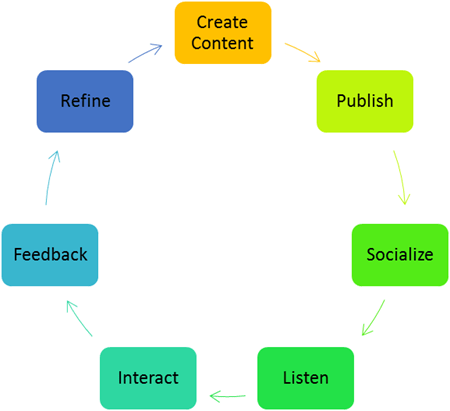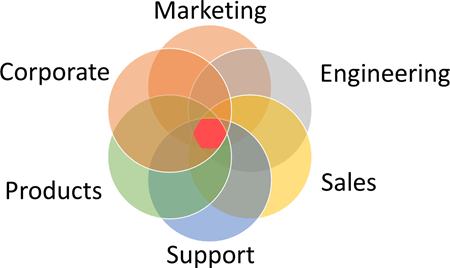I often get asked by friends, family, acquaintances and recently, companies that I’m interviewing with – what is a Technology Evangelist? While many within the technology space understand the position, it is still relatively unknown within the job marketplace. In fact, when I first started the position almost 6 years ago, it was definitely one of those niche jobs. Fast forward to today and you now see companies embracing directly-named “technology evangelist” positions or at least other names that have similar job qualities and requirements.
The most important part of the title is “evangelist” – essentially spreading the gospel. Most people, when they think of the word evangelist envision a religious evangelist. Believe it or not, this is not that far from what a technology evangelist does, but instead of communicating and inspiring a congregation about a religious theme or topic, the technology evangelist inspires businesses and individuals through interaction, content creation and communication about a technology. The end goal of the evangelist, religious or technical, is to inspire and hopefully convert the audience.
Clear? Let me evangelize a bit more and explain my views of this position and what I believe is the criteria for a good evangelist, a role I have officially held for 6 years but that I have unofficially performed for many more.
Why is the Evangelist important?
Some important aspects of evangelist DNA are the notions of “trust,” “authority” and “communication.” From each of these characteristics stem a well-rounded individual who is passionate about the product, service or technology that they are evangelizing. Without passion, there is no evangelism.
The evangelist engages in conversation and dialog as well as creates content relevant to position a product or service within the market place. We (hopefully) do this without heavy marketing or sales spins while also ensuring that the delivery of the message is clear, concise and not convoluted. We speak from experiences, with gained knowledge and, as I said, with passion.
As part of the process, we build trust within target communities over time and only through regular content communication and socialization do we gain a voice of authority within the community.
The evangelist often is a spokesperson for a company – the one publicly answering questions, engaging with analysts and the media, talking with customers and prospects. I view us as generalists that can also become extremely detailed about the topic we are evangelizing. This also depends on the type of evangelist (see “What types of Evangelists are there?” below).
I believe a good evangelist is an internal “floater” where we move easily between departments as well as business hierarchies. A good evangelist is also a great listener as it is through listening internally and externally that we gain the content and craft the stories to tell.
What is the Evangelist’s Primary Role?
Depending on the type, an evangelist actually has many roles. A developer evangelist, for example, focuses heavily on the developer community, is highly technical and is often a former (or current) developer who also has a core aptitude for communication and articulation.
A technology evangelist is a bit more generalized and focused on the bigger picture, the company or product positioning and how to build a following and less “in the weeds” than a developer evangelist would be. In a perfect world, a company would have both developer and technology evangelists who work in tandem.
The role of the evangelist, regardless of the modifier, is to build a loyal following through an honest promotion of a product or service. The means that we do this is the evangelist “secret sauce” that frequently consists of an endless cycle of iterations. I have boiled down what I typically view as this evangelism cycle into 7 core steps:
- Create Content
- Publish the content
- Socialize the content
- Listen to what people say
- Interact with the audience to better understand their reactions
- Provide feedback internally as well as externally
- Refine the message or content
Obviously, there are permutations of this and the lifespan of an individual cycle can be compressed or expanded (as well as always overlap) based on corporate initiatives or strategies. However, the evangelist is the one who iterates through the cycle, who works with marketing teams to align to marketing campaigns and strategies, who ensures that they fully understand what the product or service does or what the customers’ opinions of it are, who understands the sales process (but doesn’t do the hard sell), who provides help and support (and even evangelizes customers), and who often spends time with the engineering and developers to gain better technical insight.
This leads me to the next questions…
Where does the Evangelist reside?
As the technology evangelist for GoGrid (a cloud infrastructure provider), I resided in the Marketing department. Other technology evangelist positions seems to align within Marketing as well. But depending, again, on the modifier of the title, the evangelist could be within engineering or even within product marketing.
Honestly, I believe the evangelist positioning within the company hierarchy to be a bit arbitrary. This is because a good evangelist is able to span and talk with multiple types of roles and individuals within as well as outside of the organization.
Below is a simple Venn diagram showing typical departments or business units within an organization. The red area within the center – the overlap – is the technology evangelist sweet spot.
Again, this depends entirely on the type of evangelist – a developer evangelist may have a much larger sweet spot or overlap within the engineering and products section. A chief evangelist may have more of a corporate focus so their sweet spot will be more aligned with sales, marketing and products. And a customer evangelist (or advocate for that matter), will have more emphasis with support and perhaps sales.
Regardless of the focus, the evangelist must reside within an organization, hierarchy or department that allows for flexibility of thought as well as experimentation as evangelists often need to test and try out new ways of communication or content dissemination in order to get their message out.
What Types of Evangelists are there?
A few years ago, there were very few evangelists. Now, we are much more prevalent within small and large organizations alike. Initially and probably the most common are Technology, Developer, Platform, Open Source, and Chief Evangelists. However, a quick search on LinkedIn produces a much larger swath of evangelists: Media Technologies, API, User Experience, PR, Software Technology, Partner Business, Data, etc.
Really it is up to the organization or business to define what type of evangelist they have and if there are different ones. And if you are looking for one for your organization, be sure to look within the company first as there may be internal champions who simply need some nurturing and encouragement to become a spokesperson for the company.
That being said, a good evangelist who has passion, creative thought, energy and a networked community can succeed in almost any environment we are placed in – that is to say, once we have the knowledge, we can evangelize practically anything.
What makes an Evangelist tick?
An evangelist wakes up excited about the day ahead and with a mind full of ideas, stories and execution strategies. More often than not, we are ready to just sit down and start writing or communicating. This depends on the type of person, obviously. Moments of inspiration come frequently (for example, I came up with the idea for this article during the day and then wrote a majority of it over 2 hours at night, finishing it in the morning).
Briefly, some words that describe evangelists are: passionate, excitement around new things, making a difference, helping people, telling stories, writing, communicating, analyzing, strategizing, and evaluating new ideas and trends.
What other positions are similar to an Evangelist’s?
While I believe that evangelists are unique unto ourselves, because the position is still somewhat unknown (despite out best efforts), you can find many similar qualities or overlaps within Product Marketing, Content Marketing, Social Media Marketing, Content Strategy and Positioning, Social Media Strategy, and PR Strategy.
Some of the content marketing and social media position that I have seen could quite easily be “upgraded” to incorporate the responsibilities of an evangelist. However, sometimes companies are not ready for that jump, potentially because they do not fully understand the role as well as the power of the evangelist.
Spreading the word
An evangelist has a variety of tools at their disposal. These tools are used to spread the word. Often an evangelist will turn to any of the following to spread thought-leadership:
- blogs
- social media
- hangouts
- webinars
- white papers or technical documents
- presentations
- tradeshows
- demos
- videos
- screencasts
- chats
- discussion groups
- meetups
- emails
With careful and strategic placement of authored content, we get the message out to a variety of segmented and targeted audiences and interact therein.
Does your company have an evangelist? Do you believe that they need to? How is their role positioned? What are their responsibilities? Leave a comment and share your thoughts!
While I love the position and am currently looking to find my next career success as an evangelist, I wonder is the role is still too new for the marketplace and if companies have not yet quite seen the need for this powerful position. I believe that this should and will change over the coming years.
It’s funny, now that I think about it, that I’m evangelizing the position of the evangelist.
Oh, and if you are a company looking to hire a technology evangelist or create the role within your organization…look no further! Drop me a note and I would be happy to answer any questions or help form an evangelism strategy.
HTD says: The evangelist is a critical and strategic role in any technology company!






6 comments
Clive Sinclair
You hit the nail and I know now where I belong. So far, I was labeled a generalist by companies. I was told that they are looking for specialists and not generalists which consulting firm have a plenty. One interviewer said generalists back new technologies which tend to fail. But after reading this article. atleast I am confident to know what I am. Whether employers have this role for recruitment, in my view, depends upon, whether employer is a traditional company or a new age company which has decision makers who are more aware of current state rather than living in their cocooned walls. I guess time is coming for Evangelists and we should better be ready.
Jim Canto
@disqus_EktoXy5Unz:disqus … I am proud to call myself a generalist. Though, unfortunately, the vast majority of companies still do not appreciate the generalist.
This may be of significant interest to you: https://hackernoon.com/the-neo-generalist-and-why-we-should-all-have-one-13d651706a0c
Bennie johnston
Thanks for this post Michael. It was handy reference when crafting our own idea of what a Technology Evangelist would be here at JUST EAT (Londin, UK). http://tech.just-eat.com/jobs/technology-evangelist/
hightechdad
Great to hear. Thanks for sharing!
Joe
Hi Michael, nice post! How can you convince a traditional employer to open a technology evangelist position? What are the performance metrics you would use to measure his/her results?
hightechdad
I have found that it is often an uphill battle for this type of position. More often than not, companies will say that it is a combination of a Product Marketing Manager, Social Media Manager and perhaps a Community Manager or Content Marketing Manager that does these roles. I do believe in the coming years, this will change though. In terms of performance, much of the deliverables revolve around thought-leadership, brand awareness and positioning and content creation/curation. It is still difficult to measure user sentiment on a brand but some people try to have metrics that revolve around production (of content) and engagement (likes, shares, etc.).